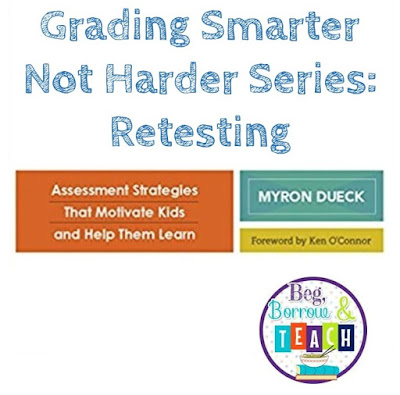Have you been searching for a way to motivate even the most resistant students to complete their work? How about ways to lessen your grading load and make the process quicker? If so, this is the series of blog posts for you!
This is the third post of the series based on the book Grading Smarter Not Harder by Myron Dueck. If you missed them, make sure you read:
Grading Smarter Not Harder: Overview
Grading Smarter Not Harder: Homework
In this post, I wanted to focus on one main concept: We can close the achievement gap with retesting. Why? Because students learn more from correcting their mistakes (test corrections or retakes) and they retain the information longer.
Here are the steps to take to maximize the effectiveness of retesting:
This is the third post of the series based on the book Grading Smarter Not Harder by Myron Dueck. If you missed them, make sure you read:
Grading Smarter Not Harder: Overview
Grading Smarter Not Harder: Homework
In this post, I wanted to focus on one main concept: We can close the achievement gap with retesting. Why? Because students learn more from correcting their mistakes (test corrections or retakes) and they retain the information longer.
Here are the steps to take to maximize the effectiveness of retesting:
1. Have the student fill out a test tracking sheet.
A crucial part of the tracking sheet is to have them think about what they will do to prepare for the retest. Taking another test without doing any new preparation for it is a waste of time and energy.
I created a FREE "Request to Retest" resource for this purpose. CLICK HERE to download this FREEBIE.
2. Choose whether the student needs to retake the original test in its entirety, only the parts they got wrong, or an entirely new test.
3. Decide whether the retest will count for whole or partial points.
Things to consider before implementing retesting:
Will you offer it to ALL students, regardless of how high they scored on the test?
What about students scoring an A?
Will you allow retesting on quizzes?
Will you allow oral quizzing?
In this alternative to paper-pencil tests, students can use any resources they want to correct their answers. When they have the new answer, they come up to the teacher to explain their evidence. Teachers can then ask other questions to see if students really have a better understanding.
How will you deter students from not preparing for the initial test just because they know they can retest?
- Let students know that they can reduce the amount if work and preparation if they fully prepare for the first test.
- Change the format of the retest so that the initial test is more user-friendly. For example, the original test might be multiple-choice, while the retest is fill-in-the-blank or short answer.
- Average the two test grades together.
- Alternatively, you can keep the higher of the two scores. This is especially useful when you're giving a different testing format on the second test. Sometimes it's the format, not the knowledge, that throws a student off.
- Use the “I Know I am Close” multiple choice testing format.
- This allows students to choose two answers from the choices provided on the test and still get credit as long as one of them is correct. The catch: The student must provide an explanation of why their choices were “close”. Dueck recommends limiting this type of option to five questions per test and reminding students that they will receive either full, half, or no points depending on the extent of their explanation. This approach can also be used to differentiate for special needs, such as ESL and nervous test-takers.




No comments:
Post a Comment